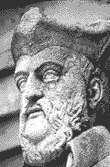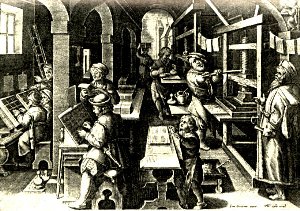
 |
 |
|
|---|---|---|
|
Accueil |
Frontispices |
|
 |

 |
 |
|
|---|---|---|
|
Accueil |
Frontispices |
|
 |
ANALYSE |
161
The printing of the Propheties: the evidence to date |
In my previous article entitled The ‘Janus Hypothesis’: its possible role both in ‘correcting’ the texts of Nostradamus’s Prophecies and in amplifying his personal biography, I advanced the view that Nostradamus’s Prophecies were in all probability set from dictation aloud, rather than directly from the manuscript. This view has since been disputed by a number of correspondents, and especially by those who would see in the individual printed letters a variety of supposedly underlying ‘codes’ – ranging from substitution-codes, via numerical and geometric codes, to simple (or, often, not-so-simple) anagrams – allegedly designed to convey some deeper, underlying ‘message’, or merely to reveal the quatrains’ secret intended sequence or application-datings. The resistance of these objectors is entirely understandable since, if the texts were set from dictation, all such theories would of course be invalidated at a stroke.
What, then, is the evidence for printing from dictation? The point de départ, as so often, is Brind’Amour, who on page 14 of his seminal Nostradamus astrophile states :
Il faut comprendre aussi comment procédaient les imprimeurs de l’époque : un ouvrier lisait le texte à haute voix pendant qu’un autre assemblait les caractères sur leur support. L’élocution du premier, l’oreille du second et ses habitudes orthographiques achevait de transformer le texte; et on ne trouve pas d’indices, dans cette littérature populaire, d’une correction des épreuves. (p.14)
Unfortunately, however, Brind’Amour does not name his source – though one might perhaps suspect some authority such as Nina Catach. Thus, it behoves us to research the matter for ourselves.
One of the obvious sources of guidance is, of course, the internal evidence of the texts themselves. The compositor had obvious difficulty in transcribing a whole variety of place-names in particular1
Similar evidence is provided by the frequency with which he managed to replace what one has to assume were originally perfectly normal words with nonsensical homonyms. Thus, in the final texts, dame is frequently replaced by d’ame and vice versa, as is deux by d’eux. The most outlandish of such cases is perhaps the substitution of cent, main for sang humain at quatrain II.62. Yet these obvious idiocies are not nonsensical and outlandish in themselves: they are nonsensical only in the linguistic contexts in which they appear – which at once suggests that the compositor, thanks to the woefully inadequate syntactical information that was available to him from the rest of Nostradamus’s deliberately obtuse and largely preposition-free text, was himself unaware of their contexts. Once again, in other words, the source of the oddities is evidently the compositor, not the author.
Nor is this the only evidence of typesetting from dictation. It is not unknown even today. My own local printer, for example, assures me that, when an urgent job is on, he often resorts to it himself – simply because it is quicker and less complicated for the keyboard-operator.
Yet none of this is likely to convince the obsessive ‘code-addict’. For him the misspellings of geographical names, the homonyms and the rest of the obvious coquillage that litters the text are all deliberate interventions of the author designed to indicate whatever it is that the ‘code-addict’ wants it to indicate – presumably reinforced by Nostradamus’s own presence in the printing-house and by his standing over the compositor to ensure that every letter was set exactly tel quel! And all this not only for the first, Lyon edition of 1555, but also for the contemporary Avignon version, to say nothing of the September 1557 edition and the presumed ‘lost’ edition of 1558. Some commentators even seem to expect him to have done the same for the posthumous 1568 edition – or rather for the whole variety of different copies of it!2
We are forced, therefore, to seek yet other evidence – evidence which, this time, is external to the Nostradamus texts. And it was this point that, in my previous article, I adduced the famous image of the typical 16th-century printing-house reproduced below:

As the details at the bottom of the engraving reveal3, this is Plate 4 of the well-known collection of engravings entitled Nova Reperta by Theodor Galle (Flemish, 1571–1633) after the original drawings of the early 1580s by Stradanus, or Jan van der Straet (Dutch, 1523–1605).4 It indicates the various processes involved in printing a book in the typical print-house of the day, and seems to be in the form of a kind of ‘circular strip-cartoon’ or bande dessinée, starting in the bottom right-hand corner, where the owner or publisher initiates the printing process.5 In front of him stands the young apprentice whose job will be to dictate the text of the manuscript on the table to the compositor at whose back he is looking and to whom he is evidently calling out. In his hands he holds a large masking-sheet which he will use to prevent his eye from inadvertently jumping from line to line, and to his left lie the torn halves of the last sheet he has dictated – partly so as to ensure that he will not dictate the same sheet twice, and partly so that, as the occasion allows, he can ferry them over to the page-compositors on the left of the picture, where they will be clipped up on the stands in front of them for reference (the ones already hanging there are clearly handwritten).
As though to confirm this, the original engraving comes, like the rest of the collection, with an explanatory Latin caption. This reads:
IMPRESSIO LIBRORUM
Potest ut una vox capi aure plurima: Linunt ita scripta mille paginas.
Generally excluded from the published reproductions, this demands to be translated as:
THE PRINTING OF BOOKS
Just as it is possible for a single voice to be seized by many an ear, so written texts spread across a thousand pages.
The reference to ‘voice’ and ‘ear’ is immediately arresting, suggesting as it does that the relationship between the apprentice’s voice and the compositor’s ear is analogous to that between the author and his readers.
However, sceptics of this interpretation inevitably see the picture in different ways. Relying largely on the fact that all known commentators on the picture have hitherto identified the youth in the foreground as collating the finished pages, they confidently assert that dictation therefore cannot possibly be in question. This begs entirely the question, of course, of just how competent those commentators have been, or of whether they have not merely done what commentators often do – namely, take their cue from some much earlier commentator who started the original ball rolling, without looking at the evidence too closely for themselves, while relying on the modern, unquestioned assumption that texts are inevitably set from manuscript. And it notably fails to answer the following questions:
1. How could the decidedly diminutive apprentice have got up to the ‘clothes-line’ on the right to collect the finished and dried pages to collate in the first place (no means of getting up there is shown, unlike the ladder leading against the left-hand wall)?
2. Why is he looking at the compositor's back, rather than at what he is allegedly doing?
3. Why is he evidently calling out to the compositor (note his open mouth)?
4. Why do the alleged ‘printed pages’ in front of him (four per sheet, apparently) contain only 5 or 6 lines apiece (unlike any known book from the time, apart from those with large woodcuts)
5. Why does each of those pages have irregular margins (again unlike any known book from the time apart from centered poetry)
6. What are the apparently torn-in-half sheets on the end of the table in the foreground doing?
7. What is the extra large sheet that he is holding in his hands?
8. Where is the all-important author’s manuscript, if not lying in front of the apprentice?
Given the well-known capacity of any picture to give rise to a variety of different interpretations, however (compare, for example, The Da Vinci Code’s startling interpretation of Da Vinci’s famous Last Supper), what is needed at this point in order finally to settle the issue is some contemporary printed description of exactly what happened in the typical printing-house of the day. To my knowledge, only one such description exists, and it is to be found in Grévin’s 1567 booklet somewhat confusingly entitled Dialogue pour les jeunes enfans…, published by Plantin. Unfortunately this is not easily available. There are apparently copies at London in the British Library (St. Pancras Reading Rooms: 07941), at Manchester Deansgate and at Nantes (Bibliothèque: NANTES-BU Lettres: Cote: 51934), though this last appears to be in Dutch. But I have been unable to consult of any of these, and feel that the cost of the French copies currently available via Abe Books and Barnes & Noble is too great to warrant a special purchase, especially as their texts may not even contain the desired information. Consequently, should any reader be able to furnish a copy (or even merely to transcribe the relevant part of Grévin’s French account), this could prove extremely helpful to the debate.
What, then are we to conclude thus far? Clearly, there is much evidence, both internal and external, in favour of the argument that the texts were indeed dictated aloud by a third party. The confident assertion of Brind’Amour; the nature of the texts themselves; the sheer practical unlikelihood that Nostradamus himself dictated all the errors deliberately; known printing practices even today; and the evidence of Stradanus’s depiction of procedures in the printing-house, complete with the engraving’s caption and its strip-cartoon-like nature as echoed in at least two of his other depictions – all these make the case virtually overwhelming.
As against this, we have only the unsourced assertions of the known commentators to the contrary – none of them based on any known first-hand evidence – together with the burning desire of the would-be ‘code-breakers’ that every letter of the printed texts be exactly ‘as Nostradamus intended’.
Pending any solid evidence to the contrary, therefore, our interim conclusion has inevitably to be that the Nostradamian texts were indeed in all probability dictated aloud —and that all attempts to ‘decode’ them on the basis of their individual letters, consequently, are fundamentally null and void.
Peter Lemesurier,
author of The Unknown Nostradamus and Nostradamus : The Illustrated Prophecies, O Books, 2003
Website : http://www.nostradamus500.com
Notes
1 See, for example, Prévost, Roger: Nostradamus, le mythe et la réalité (Laffont, 1999). Retour
2 Compare LeVert: Compare, for example, Chomarat & Laroche: Bibliographie Nostradamus (Koerner, 1989) and Robert Benazra’s Répertoire chronologique nostradamique (La Grande Conjonction, 1990). Retour
3 The image is currently online at http://www.metmuseum.org/toah/hd/prnt/hob_34.30(5).htm. Retour
4 Further prints from the collection can currently be seen at http://bibliodyssey.blogspot.com/2006/01/renaissance-discoveries-and-inventions.html. Retour
5 There seems be some evidence of the ‘circular strip-cartoon’ approach in some of the other prints, too, particularly the illustrations of water-mills and the production of spectacles. Indeed, as with the print-shop illustration, the process seems on both occasions to start in the bottom right-hand corner of the picture. Retour
Retour Analyse
Tous droits réservés © 2006 Peter Lemesurier